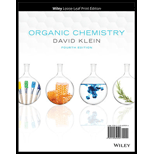
ORGANIC CHEMISTRY-PRINT (LL)-W/WILEY
4th Edition
ISBN: 9781119761105
Author: Klein
Publisher: WILEY
expand_more
expand_more
format_list_bulleted
Concept explainers
Question
Chapter 2, Problem 43PP
Interpretation Introduction
Interpretation: The two compounds that constitutional isomers of each other needs to be identified from the given compounds.
Concept Introduction: The molecules that possess same molecular formula but differ in structural arrangement of atoms in the molecule are said to be isomers of each other.
Expert Solution & Answer
Want to see the full answer?
Check out a sample textbook solution
Students have asked these similar questions
Firefly luciferin exhibits three rings. Identify which of the rings are aromatic. Identify which lone pairs are involved in establishing aromaticity. The lone pairs are labeled A-D below.
What is the [OH⁻] of a 1.80 M solution of pyridine (C₅H₅N, Kb = 1.70 × 10⁻⁹)?
What is the percent ionization in a 0.260 M solution of formic acid (HCOOH) (Ka = 1.78 × 10⁻⁴)?
Chapter 2 Solutions
ORGANIC CHEMISTRY-PRINT (LL)-W/WILEY
Ch. 2.1 - Prob. 1LTSCh. 2.1 - Prob. 3ATSCh. 2.2 - Prob. 2LTSCh. 2.2 - Prob. 4PTSCh. 2.2 - Prob. 6ATSCh. 2.4 - Prob. 3LTSCh. 2.4 - Prob. 9ATSCh. 2.5 - Prob. 4LTSCh. 2.5 - Prob. 11PTSCh. 2.9 - Prob. 6LTS
Ch. 2.9 - Prob. 15PTSCh. 2.9 - Prob. 16PTSCh. 2.10 - Prob. 18CCCh. 2.10 - Prob. 19CCCh. 2.10 - Prob. 20CCCh. 2.10 - Prob. 21CCCh. 2.10 - Prob. 22CCCh. 2.10 - Prob. 23CCCh. 2.10 - Prob. 24CCCh. 2.10 - Prob. 25CCCh. 2 - Prob. 34PPCh. 2 - Prob. 35PPCh. 2 - Prob. 36PPCh. 2 - Prob. 37PPCh. 2 - Prob. 38PPCh. 2 - Prob. 40PPCh. 2 - Prob. 42PPCh. 2 - Prob. 43PPCh. 2 - Prob. 44PPCh. 2 - Prob. 45PPCh. 2 - Prob. 46PPCh. 2 - Prob. 47PPCh. 2 - Prob. 48PPCh. 2 - Prob. 49PPCh. 2 - Prob. 50PPCh. 2 - Prob. 67ASP
Knowledge Booster
Learn more about
Need a deep-dive on the concept behind this application? Look no further. Learn more about this topic, chemistry and related others by exploring similar questions and additional content below.Similar questions
- Determine the pH of solution of HC3H5O2 By constructing an ICE table writing the equilibrium constant expression, and using this information to determine the pH. The Ka of HC3H5O2 is 1.3 x 10-5arrow_forwardDetermine if the following salt is neutral, acidic or basic. If acidic or basic, write the appropriate equilibrium equation for the acid or base that exists when the salt is dissolved in aqueous solution. If neutral, simply write only NR. Be sure to include the proper phases for all species within the reaction LiNO3arrow_forwardAn unknown weak acid with a concentration of 0.410 M has a pH of 5.600. What is the Ka of the weak acid?arrow_forward
- (racemic) 19.84 Using your reaction roadmaps as a guide, show how to convert 2-oxepanone and ethanol into 1-cyclopentenecarbaldehyde. You must use 2-oxepanone as the source of all carbon atoms in the target molecule. Show all reagents and all molecules synthesized along the way. & + EtOH H 2-Oxepanone 1-Cyclopentenecarbaldehydearrow_forwardR₂ R₁ R₁ a R Rg Nu R₂ Rg R₁ R R₁₂ R3 R R Nu enolate forming R₁ R B-Alkylated carbonyl species or amines Cyclic B-Ketoester R₁₁ HOB R R₁B R R₁₂ B-Hydroxy carbonyl R diester R2 R3 R₁ RB OR R₂ 0 aB-Unsaturated carbonyl NaOR Aldol HOR reaction 1) LDA 2) R-X 3) H₂O/H₂O ketone, aldehyde 1) 2°-amine 2) acid chloride 3) H₂O'/H₂O 0 O R₁ R₁ R R₁ R₁₂ Alkylated a-carbon R₁ H.C R₁ H.C Alkylated methyl ketone acetoacetic ester B-Ketoester ester R₁ HO R₂ R B-Dicarbonyl HO Alkylated carboxylic acid malonic ester Write the reagents required to bring about each reaction next to the arrows shown. Next, record any regiochemistry or stereochemistry considerations relevant to the reaction. You should also record any key aspects of the mechanism, such as forma- tion of an important intermediate, as a helpful reminder. You may want to keep track of all reactions that make carbon-carbon bonds, because these help you build large molecules from smaller fragments. This especially applies to the reactions in…arrow_forwardProvide the reasonable steps to achieve the following synthesis.arrow_forward
arrow_back_ios
SEE MORE QUESTIONS
arrow_forward_ios
Recommended textbooks for you

Enzymes - Effect of cofactors on enzyme; Author: Tutorials Point (India) Ltd;https://www.youtube.com/watch?v=AkAbIwxyUs4;License: Standard YouTube License, CC-BY
Enzyme Catalysis Part-I; Author: NPTEL-NOC IITM;https://www.youtube.com/watch?v=aZE740JWZuQ;License: Standard Youtube License